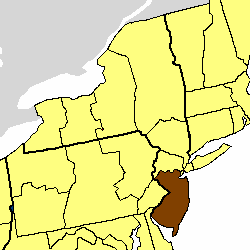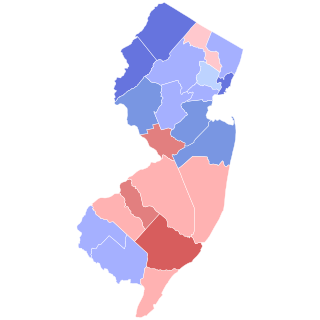
Presidential elections were held in the United States on November 8, 1904. Incumbent Republican president Theodore Roosevelt defeated the conservative Democratic nominee, Alton B. Parker. Roosevelt's victory made him the first president who ascended to the presidency upon the death of his predecessor to win a full term in his own right. This was also the second presidential election in which both major party candidates were registered in the same home state; the others have been in 1860, 1920, 1940, 1944, and 2016.

Harold Giles Hoffman was an American businessman and Republican Party politician who served as the 41st Governor of New Jersey from 1935 to 1938. His time in office was marked by controversy over his support for a sales tax and interference in the Lindbergh kidnapping case. He died while subject to an investigation for embezzlement from his bank and the state government, which he confessed to his daughter before his death.

The New Jersey General Assembly is the lower house of the New Jersey Legislature.

James Fairman Fielder was an American lawyer and Democratic politician and jurist who served as the 35th Governor of New Jersey from 1914 to 1917. He had previously served as acting governor in 1913 but stepped down from office to avoid constitutional limits on serving successive terms.

The Episcopal Diocese of New Jersey forms part of Province II of the Episcopal Church in the United States of America. It is made up of the southern and central New Jersey counties of Union, Middlesex, Somerset, Hunterdon, Mercer, Monmouth, Ocean, Burlington, Camden, Atlantic, Gloucester, Salem, Cumberland, and Cape May. It is the second oldest of the nine original Dioceses of the Episcopal Church. Services began in 1685 at St. Peter's, Perth Amboy, the oldest parish in the diocese. The diocese itself was founded in 1785.

The 1904 Democratic National Convention was an American presidential nominating convention that ran from July 6 through 10 in the Coliseum of the St. Louis Exposition and Music Hall in St. Louis, Missouri. Breaking with eight years of control by the Democratic Party's reform wing, the convention nominated conservative Judge Alton B. Parker of New York for president and Henry G. Davis of West Virginia for vice president.

The 1913 New Jersey gubernatorial election was held on November 4, 1913. Democratic acting Governor James Fairman Fielder, who resigned a week before the election so that he could succeed himself, defeated Republican former Governor Edward C. Stokes and Progressive former state senator Everett Colby.

The 1910 New Jersey gubernatorial election was held on November 8, 1910. Democratic nominee and future President Woodrow Wilson defeated Republican Assemblyman Vivian M. Lewis with 53.93% of the vote. During the campaign, Wilson underwent a political transformation from a symbol of conservative Wall Street reaction into one of the leading members of his party's progressive faction. His victory was widely understood to be the prelude to his campaign for the presidency in 1912.

The 1907 New Jersey gubernatorial election was held on November 5, 1907. Republican nominee John Franklin Fort defeated Democratic nominee Frank S. Katzenbach with 49.28% of the vote.

The 1901 New Jersey gubernatorial election was held on November 5, 1901. Republican nominee Franklin Murphy defeated Democratic nominee James M. Seymour with 50.88% of the vote.

The 1859 New Jersey gubernatorial election was held on November 8, 1859. Opposition Party nominee Charles Smith Olden defeated Democratic nominee Edwin R. V. Wright with 50.76% of the vote.

The 1856 New Jersey gubernatorial election was held on November 4, 1856. William A. Newell, running on a fusion ticket opposed to the Franklin Pierce administration, defeated Democratic nominee William Cowper Alexander with 51.29% of the vote.

The 1911 United States Senate election in New Jersey was held on January 24–25, 1911. Republican incumbent John Kean did not run for re-election to a third term. The open seat was won by Democrat James Edgar Martine with Republican former Governor Edward C. Stokes as the runner-up.

The United States Senate election of 1928 in New Jersey was held on November 6, 1928. Incumbent Democratic Senator Edward I. Edwards ran for re-election to a second term in office, but was defeated by Hamilton Fish Kean in a landslide. This was the third of four straight elections to this seat in which the incumbents were defeated.

The 1958 United States Senate election in New Jersey was held on November 4, 1958.

The 1860 Massachusetts gubernatorial election was held on November 6. Incumbent Republican governor Nathaniel Banks did not run for re-election to a fourth term. He was succeeded by Republican John Albion Andrew, a radical abolitionist.

The 1981 New Jersey Senate elections were held on November 3. The New Jersey legislature reapportioned its state legislative districts in advance of the 1981 election. The new districts resulted in many senators running for re-election in newly re-numbered districts. The election coincided with a tightly contested gubernatorial election between Thomas Kean and James Florio. Republicans gained five seats, narrowing the Democratic majority to 22–18.
Bloomfield Holmes Minch was an American businessman and politician from New Jersey.


















